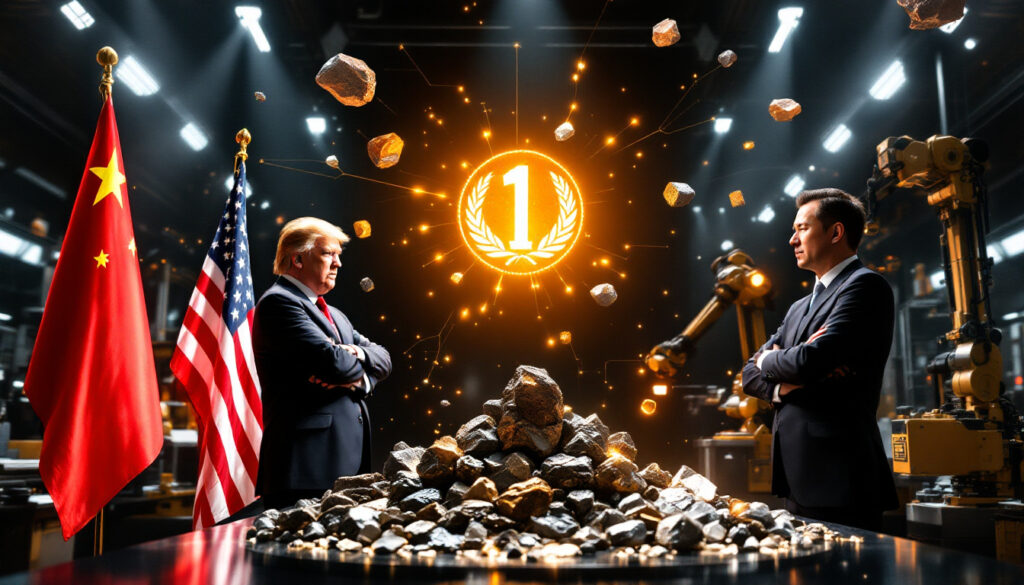China's Strategic Use of Rare Earth Elements in Trade Negotiations with the Trump Administration
China's deployment of rare earth export controls in April 2025 marks a pivotal escalation in its trade strategy against the Trump administration's reciprocal tariffs. By targeting seven specific rare earth elements—samarium, gadolinium, terbium, dysprosium, lutetium, scandium, and yttrium—Beijing has weaponized its dominance over 70% of global rare earth production. These elements, critical for defense technologies and renewable energy systems, underscore China's ability to disrupt supply chains for high-tech manufacturing. The exclusion of neodymium and praseodymium, essential for permanent magnets, reveals a calculated restraint, preserving leverage for future negotiations. Market reactions, including double-digit stock surges for Chinese producers and Australian miner Lynas, reflect investor anticipation of tightened supply. This maneuver follows a pattern of China's export restrictions, positioning rare earths as the latest front in a broader resource-based trade war.
The Geopolitical Significance of Rare Earth Elements
Composition and Global Distribution
Rare earth elements (REEs) comprise 17 metals divided into light (e.g., lanthanum, cerium) and heavy (e.g., dysprosium, terbium) categories, clustered in the periodic table's lanthanide series plus scandium and yttrium. Despite their name, REEs are relatively abundant in Earth's crust, with cerium's concentration (66.5 ppm) exceeding copper's (60 ppm). However, economically viable deposits are geographically concentrated, with China hosting 37% of global reserves compared to Vietnam (18%) and Brazil (17%).
Strategic Applications Across Industries
The unique magnetic and luminescent properties of REEs make them indispensable for:
- Defense Systems: Terbium in sonar transducers, yttrium in laser targeting
- Clean Energy: Dysprosium in wind turbine generators, neodymium in EV motors
- Consumer Electronics: Europium for LED displays, lanthanum for camera lenses
A single F-35 fighter jet requires 920 pounds of rare earth materials, while Tesla's Model 3 permanent magnet motor uses ~2 kg of neodymium. This criticality creates supply chain vulnerabilities, as 80% of U.S. REE imports originated from China in 2024.
China's Export Control Mechanism
Targeted Elements and Implementation
The April 2025 controls focus on elements with military dual-use applications:
| Element | Primary Applications | China's Global Production Share |
|---|---|---|
| Dysprosium | Neutron absorbers, nuclear reactors | 85% |
| Terbium | Sonar systems, fuel cells | 89% |
| Yttrium | Radar components, superconductors | 76% |
Exporters must now submit detailed certifications disclosing end-users, quantities, and intended applications—a process that halted gallium exports for 14 weeks in 2023. The Ministry of Commerce justifies this under Article 12 of China's Export Control Law, citing national security imperatives.
Market and Strategic Implications
China Rare Earth Holdings' 10% stock surge and Lynas' 5.1% gain reflect expectations of 15-30% price increases for controlled elements. This mirrors the 400% spike in germanium prices post-2023 controls. By exempting neodymium (Nd) and praseodymium (Pr), which constitute 75% of Lynas' output, China avoids immediate disruption to EV manufacturers while retaining future escalation options. As David Abraham of Boise State University notes: "This calibrated approach maximizes diplomatic pressure while minimizing collateral damage to Chinese firms invested in magnet production."
China's Rare Earth Dominance: Production and Processing
Vertical Integration from Mine to Magnet
China's control extends beyond mining (70% of output) to encompass:
- Separation: 90% global capacity for heavy REEs
- Metal Alloy Production: 85% market share
- Magnet Manufacturing: 92% of sintered NdFeB magnets
This vertically integrated structure, exemplified by China Northern Rare Earth Group, enables Beijing to manipulate intermediate product flows. Furthermore, 2024 saw China export 54,000 tons of rare earth oxides but only 12,000 tons of permanent magnets—retaining high-value production domestically.
Strategic Resource Stockpiling
The National Food and Strategic Reserves Administration holds:
- 30,000 tons of dysprosium (18 months' global demand)
- 45,000 tons of neodymium (12 months' demand)
These reserves allow China to weaponize exports without disrupting its own industries, a tactic previously used during the 2010 Senkaku Islands dispute when REE exports to Japan fell 72%.
Global Supply Chain Responses
Diversification Efforts
The U.S. Defense Logistics Agency has allocated $1.2 billion to:
- Resume Mountain Pass mine operations (California) targeting 15,000 tons/year by 2026
- Fund Lynas' $200 million processing facility in Texas
- Develop urban mining initiatives recovering REEs from e-waste (3,000 tons/yr capacity)
Australia's Critical Minerals Facility offers $2 billion in loans for projects like the Nolans Rare Earths Project and Iluka Resources' Eneabba refinery (HREO production: 7,500 tons/yr). However, current non-Chinese separation capacity meets only 8% of global demand.
Technological Workarounds
Researchers are pursuing alternatives:
- Reduced REE Motors: Tesla's Model S Plaid uses a 50% Nd-reduced motor
- Recycling Innovations: Ucore's RapidSX™ process achieves 95% REE recovery from magnets
- Substitute Materials: Niron Magnetics' iron nitride magnets show 60% of NdFeB performance
These solutions remain years from commercial viability, maintaining China's near-term leverage. Additionally, digital mining innovations are being explored to optimize rare earth extraction processes.
Historical Context of Mineral Export Controls
China's strategy follows a pattern of incremental resource restrictions:
| Year | Mineral | Control Measure | Price Impact |
|---|---|---|---|
| 2023 | Gallium | Export licenses required | +320% |
| 2024 | Germanium | End-use certification | +280% |
| 2025 | Graphite | 20% export tariff | +45% |
Each measure targets materials where China holds >60% production share, maximizing coercive effect while minimizing domestic economic fallout.
Implications for U.S.-China Trade Relations
The rare earth controls coincide with Trump's 25% tariff on $180 billion of Chinese imports, including EVs and semiconductors. This creates compounding pressures:
- Defense Sector: Lockheed Martin reports 3-month delays in F-35 deliveries due to terbium shortages
- Renewables: NextEra Energy pauses 2 GW of wind projects over generator supply uncertainty
- Automotive: Ford's Q2 2025 EV production forecast reduced by 12%
The Commerce Department's June 2025 deadline for a rare earth stockpile plan underscores the urgency, though analysts note current U.S. reserves cover <6 months of military needs. Investors are increasingly adopting specialized geopolitical investment strategies to navigate these tensions.
Future Escalation Scenarios
Potential Chinese next steps could include:
- Processing Technology Embargoes: Restricting export of solvent extraction equipment
- Joint Ventures Pressure: Requiring foreign firms to relocate magnet production to China
- Environmental Enforcement: Sudden mine inspections disrupting output
Conversely, U.S. countermeasures may involve:
- Invoking Section 303 of the Defense Production Act to nationalize REE production
- Imposing secondary sanctions on third-country rare earth traders
- Accelerating NATO mineral security agreements with Canada and Australia
As the International Energy Agency warns, achieving mineral supply chain independence requires 15-20 years of sustained investment—a timeline incompatible with election cycles. Consequently, staying informed about global commodity insights is crucial for investors and policymakers alike.
Conclusion
China deploys rare earths as weapon in trade war with Trump, epitomizing resource statecraft in the 21st century by leveraging geological endowment into systemic power. While immediate disruptions may be manageable, the long-term implications demand coordinated Western responses blending industrial policy, technological innovation, and diplomatic engagement. The April 2025 controls serve as both a trade war tactic and a stark reminder of globalization's fragility when critical resources become political currency.
Want to Identify the Next Major Australian Mineral Discovery?
Stay ahead of the market with Discovery Alert's proprietary Discovery IQ model, which instantly notifies investors about significant ASX mineral discoveries that could rival historic returns from companies like Lynas. Explore why major discoveries can lead to exceptional market outcomes by visiting our dedicated discoveries page.




